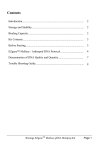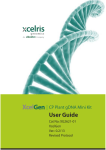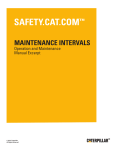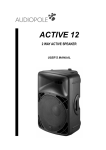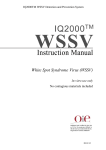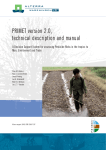Download E.Z.N.A.®HP Tissue DNA Midi Kit - Omega Bio-Tek
Transcript
E.Z.N.A.® HP Tissue DNA Midi Kit D5197-00 2 preps D5197-02 25 preps May 2013 E.Z.N.A.® HP Tissue DNA Midi Kit Table of Contents Introduction and Overview.......................................................2 Kit Contents/Storage and Stability.........................................3 Preparing Reagents.......................................................................4 HP Tissue DNA Midi Protocol...................................................5 Troubleshooting Guide...............................................................9 Ordering.........................................................................................11 Manual Revision: May 2013 Innovations in nucleic acid isolation 1 Introduction and Overview The E.Z.N.A.® HP Tissue DNA Midi Kit is designed for efficient recovery of genomic DNA up to 60 kb in size from up to 500mg of tissue samples. The special designed buffer system ensure the optimal lysis of tissue rich in fat, polysaccharides, and fibers such as brain, adipose, and muscles. In addition, this kit can isolate DNA from molluscs, insects, arthropods, roundworms, flatworms, and other invertebrate tissue samples rich in mucopolysaccharides. The procedure relies on the well established properties of the cationic detergent, cetyltrimethyl ammonium bromide (CTAB), in conjunction with the selective DNA binding capabilities of Omega Bio-tek’s HiBind® matrix. Samples are homogenized and lysed in a high salt buffer containing CTAB and digested with proteinase. After addition of chloroform, the homogenate is separate into aqueous and organic phases by centrifugation. The upper, aqueous phase is extracted and BL Buffer and ethanol are added to provide appropriate binding conditions. The sample is transferred to the HiBind® DNA Midi Column, where the genomic DNA binds to the membrane and salt and other contaminants are efficiently washed way. High-quality genomic DNA is eluted with Elution Buffer or water. Purified DNA is suitable for most downstream applications such as endonuclease digestion, thermal cycle amplification, and hybridization techniques. New in this Edition: This manual has been edited for content and redesigned to enhance user readability. • • • • 2 Equilibration Buffer is no longer included with this kit. An optional Column Equilibration Protocol has been added to the protocol for your convenience. Equilibration Buffer is replaced with 3M NaOH provided by the user. HB Buffer has been replaced with HBC Buffer. HBC Buffer must be diluted with isopropanol (provided by user) before use. HB Buffer is no longer included with this kit. Kit Contents Product D5197-00 D5197-02 Purifications 2 25 HiBind® DNA Midi Columns 2 25 15 mL Collection Tubes 2 25 MTL1 Buffer 8 mL 90 mL BL Buffer* 8 mL 90 mL HBC Buffer 5 mL 40 mL Proteinase K Solution 250 μL 3 mL RNase A 50 μL 550 μL DNA Wash Buffer 5 mL 40 mL Elution Buffer 5 mL 60 mL User Manual P P * BL Buffer contains a chaotropic salt. Use gloves and protective eye wear when handling this solution. Storage and Stability All of the E.Z.N.A.® HP Tissue DNA Midi Kit components are guaranteed for at least 12 months from the date of purchase when stored as follows. RNase A should be stored at 2-8˚C. Proteinase K Solution can be stored at room temperature for 12 months. For long-term storage (>12 months) store at 2-8°C. Store all other components at room temperature (22-25°C). Check Buffers for precipitates before use. Redissolve any precipitates by warming to 37˚C. 3 Preparing Reagents • • Dilute DNA Wash Buffer with 100% ethanol as follows and store at room temperature. Kit 100% Ethanol to be Added D5197-00 20 mL D5197-02 160 mL Dilute HBC Buffer with isopropanol as follows and store at room temperature. Kit 4 Isopropanol to be Added D5197-00 2 mL D5197-02 16 mL E.Z.N.A.® HP Tissue DNA Midi Kit Protocol E.Z.N.A.® HP Tissue DNA Midi Kit Protocol Materials and Equipment to be Supplied by User: • • • • • • • • Centrifuge equipped with swinging-bucket rotor capable of 2,000-5,000 × g Water baths, heat blocks, or incubators capable of 55-70°C Nuclease-free 15 mL centrifuge tubes 100% ethanol Isopropanol Sterile deionized water Chloroform Isoamyl alcohol Before Starting: • • • • 1. Prepare DNA Wash Buffer and HBC Buffer according to the directions in the “Preparing Reagents” section on Page 4. Prepare a mixture of chloroform:isoamyl alcohol (24:1). Heat water baths, heat blocks, or incubators capable of 55, 60, and 70°C. Heat Elution Buffer to 70°C. Pulverize 200 mg tissue in liquid nitrogen with mortar and pestle. Samples can also be ground and homogenized by bead mill. Note: The amount of starting material depends on sample type and can be increased if acceptable results are obtained with the suggested 200 mg starting amount. Use no more than 500 mg tissue per HiBind® DNA Midi Column as DNA binding capacity (400 μg) may be exceeded. Difficult tissues may require starting with less than 200 mg tissue and a doubling of all buffer volumes to ensure adequate lysis. 2. Transfer the powder in a clean 15 mL centrifuge tube. 3. Add 3 mL MTL1 Buffer and 100 μL Proteinase K Solution. Vortex briefly to mix. 4. Incubate at 60°C for a minimum of 2 hours or until entire sample is solubilized. Note: Actual incubation time varies and depends on elasticity of tissue. Most samples require no more than 4 hours. Alternatively an overnight incubation at 55°C will produce adequate results. 5 E.Z.N.A.® HP Tissue DNA Midi Kit Protocol 5. Add 3 mL chloroform:isoamyl alcohol (24:1). Vortex to mix. 6. Centrifuge at 4,000 x g for 5 minutes. 7. Carefully transfer the upper aqueous phase to a clean 15 mL centrifuge tube. Avoid the milky interface containing contaminants and inhibitors. In most cases, around 2 mL upper phase can be transferred. Note: This step will remove most of the polysaccharides and proteins from the lysate and improve spin column performance downstream. If very little upper aqueous layer is present, add 1mL MTL1 Buffer into the lysate and vortex to mix. Repeat Steps 6-7 above. Continue to the Optional RNase treatment or Step 8 below. OPTIONAL: Certain tissues such as liver have high levels of RNA which will be co-purified with DNA using this kit. While it will not interfere with PCR, the RNA may be removed at this point. Add 20 μL RNase A (25 mg/mL, assuming a sample size of 200 mg) and incubate at room temperature for 5 minutes. Proceed to Step 8. 8. Add 1 volume BL Buffer. Vortex to mix. Note: For example if the total upper aqueous phase volume is 2 mL, add 2 mL BL Buffer. 9. Incubate at 70°C for 10 minutes. A wispy precipitate may form on addition of Buffer BL, but does not interfere with DNA recovery. 10. Add 1 volume 100% ethanol. Vortex for 30 seconds to mix thoroughly. If any precipitates are seen at this point, break up the precipitates by passing through a needle using a syringe. Note: For example if the total upper aqueous phase volume is 2 mL, add 2 mL 100% ethanol. Optional Protocol for Column Equilibration 1. 2. 3. 4. 6 Add 1 mL 3M NaOH to the HiBind® DNA Midi Column. Let sit for 4 minutes at room temperature. Centrifuge at 4,000 x g for 3 minutes. Discard the filtrate and reuse the Collection Tube. E.Z.N.A.® HP Tissue DNA Midi Kit Protocol 11. Transfer the sample from Step 10, including any precipitates that may have formed, to the HiBind® DNA Midi Column. 12. Centrifuge at 4,000 x g for 5 minutes. 13. Discard the filtrate and reuse the collection tube. 14. Repeat Steps 11-13 until all the sample has been transferred to the column. 15. Add 3 mL HBC Buffer. Note: HBC Buffer must be diluted with isopropanol before use. Please see Page 4 for instructions. 16. Centrifuge at 4,000 x g for 2 minutes. 17. Discard the filtrate and reuse the collection tube. 18. Add 3.5 mL DNA Wash Buffer. Note: DNA Wash Buffer must be diluted with 100% ethanol before use. Please see Page 4 for instructions. 19. Centrifuge at 4,000 x g for 2 minutes. 20. Discard the filtrate and reuse the collection tube. 21. Repeat Steps 18-20 for a second DNA Wash Buffer wash step. 22. Centrifuge the empty HiBind® DNA Midi Column at maximum speed (<8,000 x g) for 10 minutes to dry the column. Note: This step is critical for removal of trace ethanol that may interfere with downstream applications. 7 E.Z.N.A.® HP Tissue DNA Midi Kit Protocol 23. Transfer the HiBind® DNA Midi Column to a clean 15 mL centrifuge tube. 24. Add 0.5-1 mL Elution Buffer or water heated to 70°C. 25. Let sit for 2-5 minutes at room temperature. 26. Centrifuge at 4,000 x g for 5 minutes. 27. Repeat Steps 24-26 for a second elution step. 28. Store eluted DNA at -20°C. Note: Typically a total of 200 μg DNA with absorbance ratio (A260/A280) of 1.7-1.9 can be obtained from 0.5 g animal tissue. Yields vary depending on source and quantity of starting material used. 8 Troubleshooting Guide Please use this guide to troubleshoot any problems that may arise. For further assistance, please contact the technical support staff, toll free, at 1-800-832-8896. Problem Cause Solution Incomplete lysis Increase incubation time with Buffer MTL1 / Proteinase K. An overnight incubation may be necessary. Centrifuge to remove any undigested particles. Clogged Sample too Column large Do not use more than the recommended amount of starting material. For large samples, divide into multiple tubes. Incomplete Pulverize starting material in liquid nitrogen as indicated homogenization in liquid nitrogen to obtain a fine powder. Problem Cause Solution Clogged column See above Low DNA yield Poor elution Repeat elution or increase elution volume. Incubation of column at 70°C for 5 minutes prior to centrifugation may increase yields. Poor binding to column Adjust volumes of BL Buffer and ethanol in proportion. Improper washing Problem Low A260/A280 ratio DNA Wash Buffer must be diluted with 100% ethanol as specified on Page 4 before use. HBC Buffer must be diluted with isopropanol as specified on Page 4 before use. Cause Solution Extended centrifugation during elution step Column resin may be present in eluate. Avoid higher centrifugation speeds than specified. The material can be removed from the eluate by centrifugation; it will not interfere with PCR or restriction digests. Poor cell lysis Increase incubation time with MTL1 Buffer / Proteinase K. An overnight incubation may be necessary. Trace protein contaminants Following Step 14, wash column with 1.5 mL BL Buffer + 1.5 mL 100% ethanol before proceeding to Step 15. 9 Troubleshooting Guide Problem No DNA eluted Cause Solution Poor cell lysis Increase incubation time with MTL1 Buffer / Proteinase K. An overnight incubation may be necessary. Incomplete Pulverize starting material in liquid nitrogen as indicated homogenization to obtain a fine powder. Ethanol was not Before applying DNA sample to column, add BL Buffer added to sample and 100% ethanol as indicated in Steps 8 and 10, Page 6. Ethanol was not added to DNA Wash Buffer Dilute DNA Wash Buffer with the indicated volume of 100% ethanol prior to use. HiBind®, E.Z.N.A.®, and MicroElute® are registered trademarks of Omega Bio-tek, Inc. PCR is a patented process of Hoffman-La Roche. Use of the PCR process requires a license. 10 Ordering Information The following components are available for purchase separately. (Call Toll Free at 1-800-832-8896) Product Part Number BL Buffer (100 mL) PD062 DNA Wash Buffer (100 mL) PS010 Elution Buffer (100 mL) PDR048 Proteinase K Solution (2 mL) AC115 Proteinase K Solution (10 mL) AC116 11 Notes: 12


















